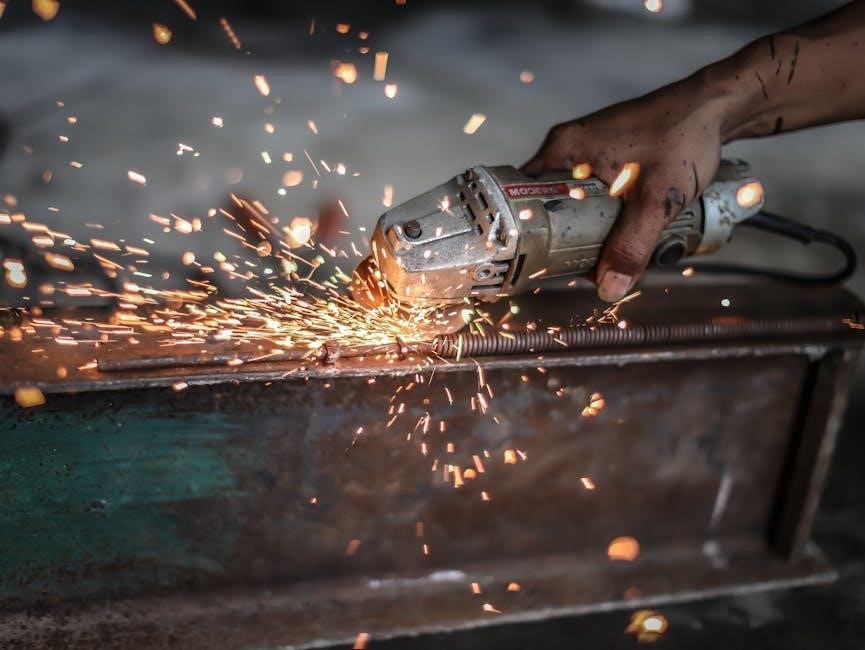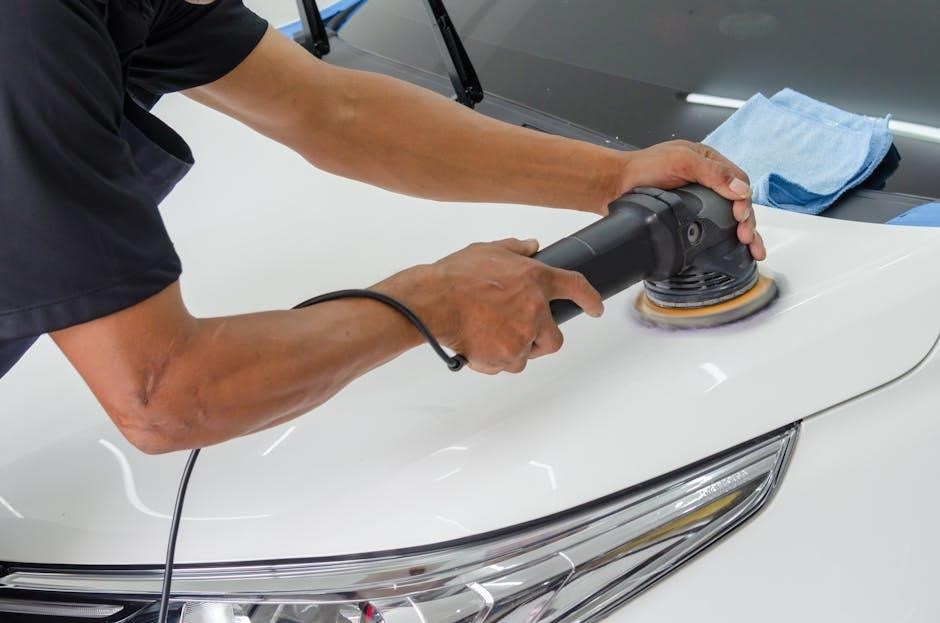A manual surface grinding machine is a machine tool used for producing smooth‚ flat surfaces on metallic and non-metallic materials․ These machines rely on the operator’s skill to achieve desired precision and finish with careful control and operation․ The operator controls the grinding process․
Definition and Purpose
A manual surface grinding machine is a precision machine tool designed to refine the surfaces of materials‚ typically metals‚ to achieve exceptional flatness and finish․ Unlike automated counterparts‚ these machines rely heavily on the operator’s direct involvement and skill throughout the grinding process․ The operator controls the machine’s movements‚ grinding wheel depth‚ and feed rate‚ demanding a keen understanding of the material being worked on and the desired outcome․ This hands-on approach allows for greater flexibility in handling intricate parts and making real-time adjustments based on visual and tactile feedback․
The primary purpose of a manual surface grinding machine is to remove material from a workpiece to create a smooth‚ flat‚ and dimensionally accurate surface․ This is achieved through the use of an abrasive grinding wheel that rotates at high speeds․ The workpiece is carefully moved under the wheel‚ either by hand or with the assistance of manual controls‚ to gradually remove material and achieve the desired surface finish․ These machines are frequently used in toolrooms‚ machine shops‚ and manufacturing environments where high precision and surface quality are paramount․ They are essential for producing components that require tight tolerances and superior surface characteristics․
Key Components of a Manual Surface Grinding Machine
A manual surface grinding machine consists of several essential components that work together to achieve precise material removal and surface finishing․ The base provides a stable foundation‚ minimizing vibrations that could affect accuracy․ The column‚ mounted on the base‚ supports the grinding head and allows for vertical movement․ The grinding head houses the motor and spindle‚ which drives the grinding wheel․ Different types of grinding wheels are used depending on the material and desired finish․
The worktable is a flat‚ horizontal surface where the workpiece is secured․ It can be moved manually in both the X and Y axes‚ allowing the operator to position the workpiece under the grinding wheel․ The crossfeed handwheel controls the movement of the worktable in the X-axis‚ while the longitudinal feed handwheel controls the movement in the Y-axis․ A vertical feed handwheel adjusts the height of the grinding head‚ controlling the depth of cut․ Coolant system and wheel dressing mechanisms are essential for efficient operation;
Types of Manual Surface Grinding Machines
Manual surface grinding machines come in several types‚ each designed for specific applications and work piece configurations․ The most common types are horizontal spindle and vertical spindle grinders․ Horizontal spindle surface grinders use the periphery of the grinding wheel to create a flat surface․ These machines are well-suited for general-purpose grinding and are commonly used for producing flat surfaces on a variety of materials․
Vertical spindle surface grinders‚ on the other hand‚ use the end of the grinding wheel to grind the surface․ These machines are often used for grinding large‚ flat surfaces and are capable of removing material more quickly than horizontal spindle grinders․ Another classification is based on the table movement: reciprocating table and rotary table grinders․ Reciprocating table grinders move the work piece back and forth under the grinding wheel‚ while rotary table grinders rotate the work piece under the grinding wheel․ Each type offers unique advantages․
Working Principle
The working principle of a manual surface grinding machine involves using an abrasive grinding wheel to remove material from a work piece to achieve a flat‚ smooth surface․ The work piece is typically mounted on a table that can be moved horizontally and vertically․ The grinding wheel is mounted on a spindle that rotates at high speed․
First‚ the operator positions the work piece under the grinding wheel․ The operator then manually adjusts the height of the grinding wheel to control the depth of cut․ As the grinding wheel rotates‚ it removes material from the work piece․ The operator moves the table back and forth and side to side to grind the entire surface of the work piece‚ controlling the feed rate and depth of cut․ Coolant is often used to dissipate heat and flush away debris․ Precision is achieved through careful control of the machine’s movements‚ and the operator’s skill․

Applications
Manual surface grinding machines are versatile tools used across various industries for achieving precision finishing․ They are particularly valuable in tool and die making‚ where accuracy is paramount for creating molds‚ dies‚ and punches․ These machines are also essential in machine shops for producing flat and parallel surfaces on parts that require tight tolerances․
In the automotive sector‚ they are used for reconditioning engine components such as cylinder heads and valve seats․ The aerospace industry relies on manual surface grinding for manufacturing precision parts that meet stringent quality standards․ Furthermore‚ these machines are employed in the production of precision instruments‚ gauges‚ and fixtures․ The ability to manually control the grinding process makes them ideal for small batch production‚ prototyping‚ and intricate work that requires a high degree of operator skill and attention to detail․ Their adaptability ensures consistent results․
Advantages of Manual Machines
Manual surface grinding machines offer several distinct advantages‚ particularly in settings where flexibility and operator control are paramount․ One significant benefit is their lower initial cost compared to CNC machines‚ making them accessible to smaller shops or those with limited budgets․ Their simplicity in design translates to ease of maintenance and reduced downtime‚ as repairs are often straightforward and can be performed by in-house technicians․
Manual machines excel in handling small batch production and prototype work‚ where the setup time for automated systems may not be justifiable․ The direct involvement of the operator provides a high degree of control over the grinding process‚ allowing for precise adjustments and corrections․ This is particularly valuable for intricate parts or when working with delicate materials․ Furthermore‚ skilled operators can achieve exceptional surface finishes and dimensional accuracy․ They provide a hands-on approach․

Disadvantages of Manual Machines

Despite their advantages‚ manual surface grinding machines also present several limitations․ One major drawback is the reliance on operator skill and experience․ The quality and consistency of the finished product heavily depend on the operator’s proficiency‚ leading to potential variations in surface finish and dimensional accuracy․ This can be a concern in high-volume production environments where consistency is crucial․
Manual machines are also less efficient for large production runs․ The grinding process is slower compared to automated systems‚ as each pass requires manual adjustment and control․ Operator fatigue can further reduce efficiency and increase the risk of errors․ Additionally‚ manual machines may struggle with complex geometries or intricate designs that require precise‚ repeatable movements․ The physical demands on the operator can be significant․ CNC machines are more efficient for complex shapes․
Maintenance and Safety Precautions
Proper maintenance and adherence to safety precautions are essential for ensuring the longevity and safe operation of manual surface grinding machines․ Regular maintenance tasks include lubricating moving parts‚ cleaning the machine to remove debris and swarf‚ and inspecting the grinding wheel for wear or damage․ The grinding wheel must be balanced and dressed regularly․ The wheel’s condition can impact surface quality․ Replacing worn or damaged components promptly is also crucial․
Safety precautions are paramount to prevent accidents and injuries․ Operators should always wear appropriate personal protective equipment (PPE)‚ including safety glasses‚ gloves‚ and hearing protection․ Ensure the grinding wheel is properly guarded and that the machine is securely mounted․ Never operate the machine without proper training and understanding of its controls and safety features․ Regularly inspect the machine’s electrical components and wiring to prevent electrical hazards․ Always disconnect the power supply before performing maintenance or repairs․ Keep the work area clean and free of obstructions to prevent slips and falls․ Store flammable materials away from the machine․
Selecting a Manual Surface Grinding Machine
Selecting the right manual surface grinding machine involves considering several factors to ensure it meets your specific needs and requirements․ First‚ evaluate the size and type of workpieces you will be grinding․ Determine the required table size and grinding capacity to accommodate your typical projects․ Consider the machine’s accuracy and precision capabilities‚ as well as the desired surface finish․

Evaluate the machine’s construction and build quality‚ opting for models with robust frames and durable components․ Inspect the spindle and grinding wheel mounting system for stability and reliability․ Check the ease of use and ergonomics of the machine’s controls and adjustments․ Look for features like adjustable grinding wheel speeds and feed rates to optimize performance․ Consider the availability of spare parts and service support from the manufacturer or supplier․
Consider the cost of the machine‚ including initial purchase price‚ operating expenses‚ and maintenance costs․ Compare different models and brands to find the best value for your budget․ Read reviews and testimonials from other users to gain insights into the machine’s performance and reliability․ It is important to choose a supplier that is reliable․
Manufacturers and Suppliers
The market for manual surface grinding machines includes various manufacturers and suppliers offering diverse models and services․ Several established manufacturers specialize in producing high-quality grinding machines for industrial applications․ These companies often have a long history of engineering expertise and a reputation for reliability and performance․ Some well-known manufacturers include companies that offer a wide range of grinding solutions․
In addition to manufacturers‚ numerous suppliers distribute manual surface grinding machines from various brands․ These suppliers may offer a wider selection of machines and provide additional services such as installation‚ training‚ and maintenance support․ Some suppliers specialize in specific types of grinding machines or cater to particular industries․
When choosing a manufacturer or supplier‚ consider factors such as their reputation‚ product quality‚ customer service‚ and pricing․ Look for companies with a proven track record of delivering reliable machines and providing excellent support․ Check online reviews and testimonials to gauge customer satisfaction and identify any potential issues․ Consider the supplier’s location and proximity to your facility for convenient access to service and support․ Choosing a local supplier is recommended․




